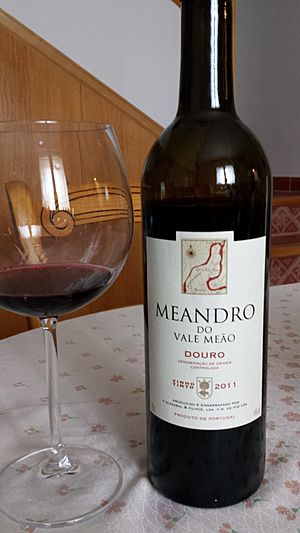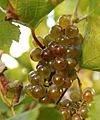Douro DOC facts for kids
| UNESCO World Heritage Site | |
|---|---|

Vineyards in Alto Douro
|
|
| Location | Trás-os-Montes e Alto Douro Province, Portugal |
| Criteria | Cultural: (iii)(iv)(v) |
| Inscription | 2001 (25th Session) |
| Area | 24,600 ha (61,000 acres) |
| Buffer zone | 225,400 ha (557,000 acres) |
The Douro region in Portugal is famous for its special wines. It is located around the Douro River in the Trás-os-Montes e Alto Douro area. People sometimes call it Alto Douro, which means "upper Douro." This is because it is far up the river from the city of Porto. Mountains protect the region from the ocean's weather.
The Douro region has the highest wine classification in Portugal. This is called a Denominação de Origem Controlada (DOC). It means the wines are made in a special way in this specific area. The region is also known as a "Protected Designation of Origin" in many countries.
While the Douro is famous for Port wine, it also makes a lot of "table wine." Table wine is regular wine that is not fortified. Fortified wines have extra alcohol added. The table wines from this area are usually called "Douro wines."
The Alto Douro was one of Portugal's main regions identified by a geographer named Amorim Girão. This was in a study from 1927 to 1930. Later, it joined with Trás-os-Montes to form a larger province.
Wines from the Douro region can be different styles. Some are light, like Bordeaux wines. Others are rich and aged in new oak barrels, like Burgundian wines.
Contents
Exploring the Douro Region's Geography and Climate
The Douro wine region is found in the valley of the Douro River. It also includes the lower valleys of its smaller rivers. These include the Varosa, Corgo, Távora, Torto, and Pinhão rivers. Mountains like Marão and Montemuro protect the region from Atlantic winds.
This area has a continental climate. This means it has hot, dry summers and cold winters.
The region is divided into three main parts, from west to east:
- Baixo Corgo ("below Corgo") is the westernmost part. It has the mildest weather and gets the most rain. About 14,000 hectares of vineyards are here. This was the first area to have vineyards. However, its wines are generally seen as less famous than those from other parts.
- Cima Corgo ("above Corgo") is the largest part. It has about 19,000 hectares of vineyards. The village of Pinhão is in the center of this area. Many famous Quintas (wine estates) are located here.
- Douro Superior ("upper Douro") is the hottest and driest part. It stretches all the way to the border with Spain. It has 8,700 hectares of vineyards. This area produces many high-quality wines. It is the hardest part to reach, so it was planted most recently. It is still growing today.
You will see many terraced vineyards in the Douro region. These are vineyards built on slopes like steps. Vineyards for Port wine usually grow on schist soil. Areas with granite soil are used for making table wine.
The Douro winemaking region was named a World Heritage Site in 2001. This means it is very important to the world's culture and history.
Discovering Douro's Grape Varieties
The Douro region grows many different types of grapes. Most of them are local Portuguese grapes. For a long time, people did not study the grape varieties very well. Vineyards often had many different types of grapes planted together. Owners sometimes did not even know all the varieties they were growing.
In the 1970s, a big effort was made to identify the main grapes. They found that Touriga Nacional, Tinta Roriz, Touriga Franca, Tinta Cão, and Tinta Barroca were the most important dark-skinned grapes. Later, Tinta Amarela and Sousão were also included. This research was very important. It helped create the new wave of top Douro wines. It also made people focus more on the grapes used for Port wine.
Today, most top Quintas plant vineyards with only one type of grape. They focus on a small number of varieties. However, older vineyards with mixed grapes will still be used for many years.
Images for kids
de:Alto Douro nl:Alto Douro ja:アルト・ドウロ・ワイン生産地域 pl:Alto Douro pt:Região Vinhateira do Alto Douro ro:Douro DOC fi:Alto Douro
See also
 In Spanish: Douro (vino) para niños
In Spanish: Douro (vino) para niños











